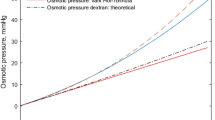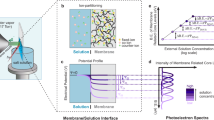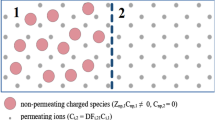Abstract
IN spite of the widespread use of radioactive tracers in the study of permeation of biological tissues, it is well known that the permeability coefficient derived from tracer exchange may differ appreciably from that derived from net flow1–4, as, for example, for water flow in the frog skin and toad bladder1–3 and sugar transport in red blood cells4. There is a similar ambiguity in the use of the “flux ratio” to evaluate the forces promoting transport. For simple passive flow across a membrane the original formulation2,5,6 for the ratio of “unidirectional fluxes” was given as  where X is the negative electrochemical potential difference of the test species, and R and T are the gas constant and absolute temperature, respectively. Deviations from this formula (that is an “abnormality” of the flux ratio) were considered to indicate additional forces such as solvent drag or active transport. Although the flux ratio equation has been useful in characterizing the forces which influence net transport, important exceptions have been noted1,2,7,8. A clear example is the potassium flow in the poisoned squid axon, in which the flux ratio is markedly abnormal in spite of the apparent absence of either solvent drag or active transport7.
where X is the negative electrochemical potential difference of the test species, and R and T are the gas constant and absolute temperature, respectively. Deviations from this formula (that is an “abnormality” of the flux ratio) were considered to indicate additional forces such as solvent drag or active transport. Although the flux ratio equation has been useful in characterizing the forces which influence net transport, important exceptions have been noted1,2,7,8. A clear example is the potassium flow in the poisoned squid axon, in which the flux ratio is markedly abnormal in spite of the apparent absence of either solvent drag or active transport7.
This is a preview of subscription content, access via your institution
Access options
Subscribe to this journal
Receive 51 print issues and online access
$199.00 per year
only $3.90 per issue
Buy this article
- Purchase on Springer Link
- Instant access to full article PDF
Prices may be subject to local taxes which are calculated during checkout
Similar content being viewed by others
References
Koefoed-Johnsen, V., and Ussing, H. H., Acta Physiol. Scand., 28, 60 (1953).
Ussing, H. H., in Alkali Metal Ions in Biology (Springer, Berlin, 1960).
Hays, R. M., and Leaf, A., J. Gen. Physiol., 45, 905 (1962).
LeFevre, P. G., and McGinniss, G. F., J. Gen. Physiol., 44, 87 (1960).
Ussing, H. H., Acta Physiol. Scand., 19, 43 (1949).
Teorell, T., Arch. Sci. Physiol., 3, 205 (1949).
Hodgkin, A. L., and Keynes, R. D., J. Physiol., 128, 51 (1955).
Levi, H., and Ussing, H. H., Acta Physiol. Scand., 16, 232 (1948).
Kedem, O., and Essig, A., J. Gen. Physiol., 48, 1947 (1965).
Gottlieb, M. H., and Sollner, K., Biophys. J., 8, 515 (1968).
Gottlieb, M. H., Neihoff, R., and Sollner, K., J. Phys. Chem., 61, 154 (1957).
Essig, A., Kedem, O., and Hill, T. L., J. Theoret. Biol., 13, 72 (1966).
Shean, G. M., and Sollner, K., Ann. NY Acad. Sci., 137, 759 (1966).
Snell, F. M., Shulman, S., Spencer, R. P., and Moos, C., Biophysical Principles of Structure and Function, 320 (Addison-Wesley, london, 1965).
Author information
Authors and Affiliations
Rights and permissions
About this article
Cite this article
DESOUSA, R., LI, J. & ESSIG, A. Flux Ratios and Isotope Interaction in an Ion Exchange Membrane. Nature 231, 44–45 (1971). https://doi.org/10.1038/231044a0
Received:
Issue Date:
DOI: https://doi.org/10.1038/231044a0
This article is cited by
-
Influence of membrane heterogeneity on kinetics of nonelectrolyte tracer flows
The Journal of Membrane Biology (1976)
-
Effect of transepithelial concentration gradients on the passive fluxes of sodium across toad bladder
The Journal of Membrane Biology (1976)
-
Deviating flux rations for Na+ in ouabain-treated frog skin
Pfl�gers Archiv European Journal of Physiology (1975)
-
Tracer flow, permeability, and partial conductance
The Journal of Membrane Biology (1975)
-
Kinetics of tracer flows and isotope interaction in an ion exchange membrane
The Journal of Membrane Biology (1974)
Comments
By submitting a comment you agree to abide by our Terms and Community Guidelines. If you find something abusive or that does not comply with our terms or guidelines please flag it as inappropriate.



